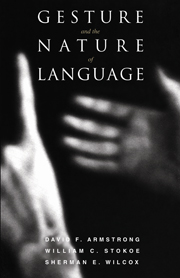Book contents
- Frontmatter
- Contents
- Acknowledgments
- Introduction: language from the body
- 1 The universe of gesture
- 2 The nature of gesture
- 3 Are signed and spoken languages differently organized?
- 4 Is language modular?
- 5 Do we have a genetically programmed drive to acquire language?
- 6 Language from the body politic
- 7 The origin of syntax: gesture as name and relation
- 8 Language from the body: an evolutionary perspective
- References
- Author index
- Subject index
2 - The nature of gesture
Published online by Cambridge University Press: 05 June 2012
- Frontmatter
- Contents
- Acknowledgments
- Introduction: language from the body
- 1 The universe of gesture
- 2 The nature of gesture
- 3 Are signed and spoken languages differently organized?
- 4 Is language modular?
- 5 Do we have a genetically programmed drive to acquire language?
- 6 Language from the body politic
- 7 The origin of syntax: gesture as name and relation
- 8 Language from the body: an evolutionary perspective
- References
- Author index
- Subject index
Summary
The retinal image produced by the hand of a gesticulating speaker is never the same from moment to moment, yet the brain must consistently categorize it as a hand.
Semir Zeki, The visual image in mind and brainOne way in which the central role of gesture in language can be understood is to consider gesture as a critical link between our conceptualizing capacities and our linguistic ability. This chapter will begin by exploring two opposing approaches to the study of language with special significance for how we might unify our understanding of spoken and signed languages. Next, we will explore the nature of gesture and how it is involved in the evolution and structure of human cognition. Then, we will demonstrate how visible gesture might link cognition to language.
In Chapter 7, we will develop the idea that visible gestures hold the seed of syntax. Here, we suggest that visible gestures played a pivotal role in the evolution of the cognitive capacities underlying linguistic competence. A critical function of the early conceptual abilities of hominids was to categorize an essentially unlabeled world of objects and events. Once we were able to categorize and conceptualize, visible (primarily manual) gestures – hands acting – were themselves categorized as prototypical objects and actions in the world. These capabilities led to the development of language and, once again, enabled us to marshall these concepts and articulators as linguistic symbols.
- Type
- Chapter
- Information
- Gesture and the Nature of Language , pp. 27 - 63Publisher: Cambridge University PressPrint publication year: 1995



